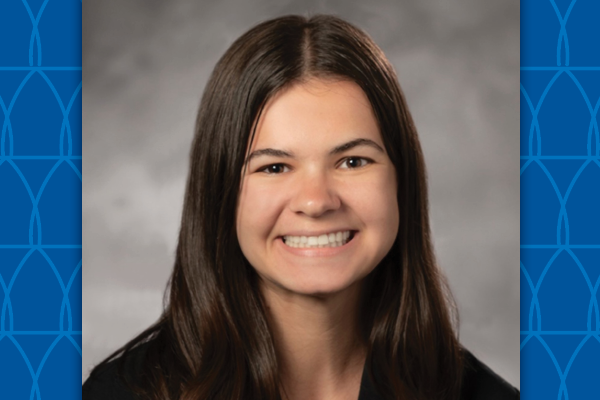
Olivia Lambert will complete the two-year Master of Biostatistics degree program in May 2025. Her hometown is Macomb, Michigan. Olivia graduated from the University of Michigan with an undergraduate double major of Biology, Health & Society and Biopsychology, Cognition, & Neuroscience. She minored in Applied Statistics.
What first sparked your interest in biostatistics?
I’ve always been good at math, but didn’t think I could ever do anything practical with it. Through my undergraduate research experiences, I developed strong interests in epidemiological and medical research. During my junior year, I took an introductory biostatistics course, and I realized it was the perfect way to combine my quantitative skills with my drive to improve human health.
What attracted you to the Master of Biostatistics program at Duke?
Duke’s program stood out to me for a number of reasons, most notably its relatively small cohort size, emphasis on applied methods, and career prospects. The Duke School of Medicine, and the Research Triangle area overall, are great places to be if you want to be involved in impactful biomedical research. I was also drawn to the area for its proximity to both the mountains and the beach, especially having lived in Michigan my whole life.
What do you enjoy most about this program?
I enjoy the collaborative culture of this program; I have never felt like I’m in competition with my peers, and everyone is eager to build each other up and work together on assignments. The instructors, faculty, and program coordinators are very supportive and genuinely want you to succeed. There is a very strong sense of community in the program and the department, on the whole.
What are some of your favorite classes?
My favorite classes have been BIOSTAT 702 (Applied Biostatistical Methods I), BIOSTAT 705 (Applied Biostatistical Methods II), and BIOSTAT 719 (Generalized Linear Models). This is a sequence of statistical inference/modeling courses that emphasize working with real data, teaching you how to think like a biostatistician and preparing you for things you may encounter on the job.
What skills have you gained from the program?
I’ve learned how to think critically, program in both R and SAS, and identify appropriate statistical methods for various types of data/study designs. I’ve also gained skills in technical writing, presenting my work to various audiences, and effectively collaborating with interdisciplinary research teams.
What does the program do well?
The courses are set up in a way to emulate what working as a biostatistician will be like, through aspects such as collaborative group projects and working with sometimes messy data. There are also lots of opportunities to get involved in research outside the classroom, whether through a formal internship experience or working on faculty-led projects. Another unique feature of this program is the mandatory career development courses, where we learn valuable skills, such as resume building, interviewing, and networking. Laura Coutts, our director of career services, is a great resource for one-on-one career advising.
What's the most challenging aspect of the program?
I think the most challenging aspect is finding a good work-life balance. Our coursework can be very difficult and time consuming, which can be tough to manage in addition to research, jobs, and other obligations. I learned quickly how important it is to have good time management skills and stay organized, while also making sure to carve out time for myself.
Did you participate in a summer internship?
Yes, I’ve participated in the Duke BERD Core Training and Internship Program (BCTIP) since January and will continue this internship through graduation.
What type of work did you do for your internship?
I work with the Duke Aging Center’s Data Science and Statistics Lab. This is a group of biostatisticians and other quantitative scientists that collaborate with researchers throughout the medical school on aging-related projects. In this role, I function as a collaborative biostatistician and have had the opportunity to conduct analyses with minimal supervision, which has been an amazing learning experience. Some of my duties include creating statistical analysis plans, data cleaning, conducting analyses, and presenting results to investigators. I also had the opportunity to present the background and preliminary findings for one of my projects to members of Duke’s biostatistics and medical community.
What advice do you have for incoming students?
The two years that you spend in the program are going to fly by, so take advantage of your time here while you can! Get involved in research, use your resources, and don’t be afraid to ask for help!
What type of work do you see yourself doing in the future?
I’m currently applying for both full-time Biostatistician positions and Epidemiology PhD programs, so my plans right now are still up in the air. I really see myself working in a collaborative research environment like I’ve been doing in my internship, as I have a broad range of clinical interests that I’d like to further explore through working on a variety of projects.
What do you like to do outside of work?
I like to read, watch TV, hike, go to sporting events, and spend time with my friends.